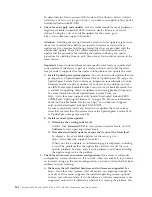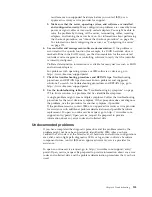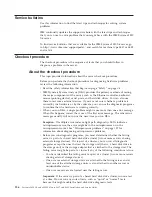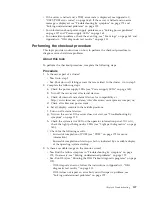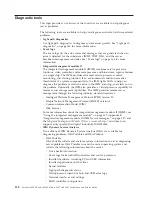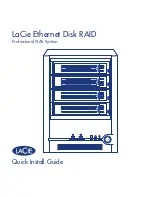
Table 36. Light path diagnostics LEDs description (continued)
LED
Description
Locate button/LED
Press the locate button to visually locate the server among other
servers. When you press the locate button, the LED will be lit and it
will continue to be lit until you press it again to turn it off. This
Locate button is also used as the physical presence for the Trusted
Platform Module (TPM). You can use IBM Systems Director to light
this LED remotely. This LED is controlled by the IMM2.
Microprocessor error LED
When this LED is lit, it indicates that a microprocessor error has
occurred.
PCIe slot error LED
When these LEDs are lit, they indicate that an error has occurred in
PCIe slots.
Power button/LED
Press this button to turn the server on and off manually or to wake
the server from a reduced-power state. The states of the power-on
LED are as follows:
Off:
Input power is not present, or the power supply or the LED
itself has failed.
Flashing rapidly (3 times per second):
The server is turned off
and is not ready to be turned on. The power-on button is
disabled. This lasts approximately 10 seconds after input power
has been applied or restored.
Flashing slowly (once per second):
The server is turned off and
is ready to be turned on. You can press the power-on button to
turn on the server.
Lit:
The server is turned on.
Power supply error LED
When this yellow LED is lit, it indicates that a power supply error
has occurred.
System error LED
When this yellow LED is lit, it indicates that a system error has
occurred. A system-error LED is also on the rear of the server. This
LED is controlled by the IMM2. Additional information can also be
seen on the LCD display panel (see “LCD system information
display panel” on page 28 for more information).
Event logs
This topic provides an overview of the server generated event logs that contains
the error codes and messages to solve roblems.
Error codes and messages are displayed in the following types of event logs:
v
POST event log:
This log contains the most recent error codes and messages
that were generated during POST. You can view the contents of the POST event
log from the Setup utility (see “Starting the Setup utility” on page 126). For
more information about POST error codes, see Appendix C, “UEFI/POST error
codes,” on page 1665.
v
System-event log:
This log contains POST and system management interrupt
(SMI) events and all events that are generated by the baseboard management
controller that is embedded in the integrated management module (IMM). You
can view the contents of the system-event log through the Setup utility and
through the Dynamic System Analysis (DSA) program (as IPMI event log).
The system-event log is limited in size. When it is full, new entries will not
overwrite existing entries; therefore, you must periodically clear the
system-event log through the Setup utility. When you are troubleshooting an
error, you might have to save and then clear the system-event log to make the
168
System x3850 X6 and x3950 X6 Types 3837 and 3839: Installation and Service Guide
Содержание X3850 X6
Страница 1: ...System x3850 X6 and x3950 X6 Types 3837 and 3839 Installation and Service Guide...
Страница 2: ......
Страница 3: ...System x3850 X6 and x3950 X6 Types 3837 and 3839 Installation and Service Guide...
Страница 138: ...120 System x3850 X6 and x3950 X6 Types 3837 and 3839 Installation and Service Guide...
Страница 225: ...25 26 27 Chapter 5 Parts listing System x3850 X6 and x3950 X6 Types 3837 and 3839 207...
Страница 1682: ...1664 System x3850 X6 and x3950 X6 Types 3837 and 3839 Installation and Service Guide...
Страница 1706: ...1688 System x3850 X6 and x3950 X6 Types 3837 and 3839 Installation and Service Guide...
Страница 1710: ...1692 System x3850 X6 and x3950 X6 Types 3837 and 3839 Installation and Service Guide...
Страница 1728: ...1710 System x3850 X6 and x3950 X6 Types 3837 and 3839 Installation and Service Guide...
Страница 1729: ......
Страница 1730: ...Part Number 00FH434 Printed in USA 1P P N 00FH434...

